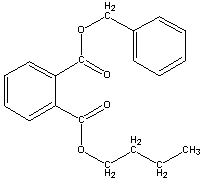
NTP Study Reports

NTP Study Reports
Home » Study Results & Research Projects » NTP Study Reports » All Long-Term Reports » Abstract for TR-213 - Butyl Benzyl Phthalate

| Chemical Formula: C19H20O4 | - | 3D Structure* |
|---|---|---|
| *To view structure, download free Chemscape Chime Plug-in | ||
A carcinogenesis bioassay of butyl benzyl phthalate, a plasticizer for vinyl chloride plastics, was accomplished by feeding diets containing 6,000 or 12,000 ppm of the phthalate to groups of 50 F344/N rats and 50 B6C3F1 mice of each sex for 28 to 103 weeks.
Mean body weights of dosed female rats and mice of each sex were lower than those of the control animals throughout most of the study.
After week 14, an increasing number of dosed male rats died as a result of an unexplained internal hemorrhaging, and all surviving male rats were killed at week 29 to 30. Because of compound-related mortality, butyl benzyl phthalate was not adequately tested for carcinogenicity in male F344/N rats.
Mononuclear cell leukemias occurred at a statistically significant (P=0.011) increased incidence in the high-dose group of female rats when compared with the control group and with a significantly (P=0.006) increasing trend (controls 7/49, 14%; low-dose 7/49, 14%; high-dose 18/50, 36%). The incidence in the high-dose group and the overall trend remained statistically significant (P=0.008 and P=0.019) when compared with the historical incidence for F344/N female rats with leukemia at this laboratory (77/ 399, 19%). Further, this leukoproliferation was generally characterized by splenomegaly and often by hepatomegaly.
Administration of butyl benzyl phthalate was not associated with increased incidences of any type of tumor among male or female mice.
Tumor rates were decreased in female rats for fibroadenomas of the mammary glands (20/49, 14/49, 9/50) and in male mice for lymphomas of the hematopoietic system (13/50, 11/49, 4/50) and for alveolar/bronchiolar adenomas or carcinomas (17/50, 11/49, 8/50).
Under the conditions of this bioassay, butyl benzyl phthalate was probably carcinogenic for female F344/N rats, causing an increased incidence of mononuclear cell leukemias. The male F344/N rat study was considered inadequate for evaluation due to compound-related toxicity and early mortality. Butyl benzyl phthalate was not carcinogenic for B6C3F1 mice of either sex.
Levels of Evidence of Carcinogenicity: | ||
| Male Rats: | Inadequate Study | |
| Female Rats: | Positive | |
| Male Mice: | Negative | |
| Female Mice: | Negative | |
Synonyms: BBP; benzyl butyl phthalate; phthalic acid; benzyl butyl ester; Santicizer 160
Report Date: August 1982
Target Organs & Incidences from 2-year Studies
You may link to the full technical report in pdf format ( Note: A print ready copy of the document is presented in Portable Document Format (pdf) which requires the Acrobat Reader plug-in -- download a free copy of the reader.)
Web page last updated on October 14, 2004
The National Institute of Environmental Health Sciences is one of the National Institutes of Health within the U.S. Department of Health and Human Services. The National Toxicology Program is headquartered on the NIEHS campus in Research Triangle Park, NC.